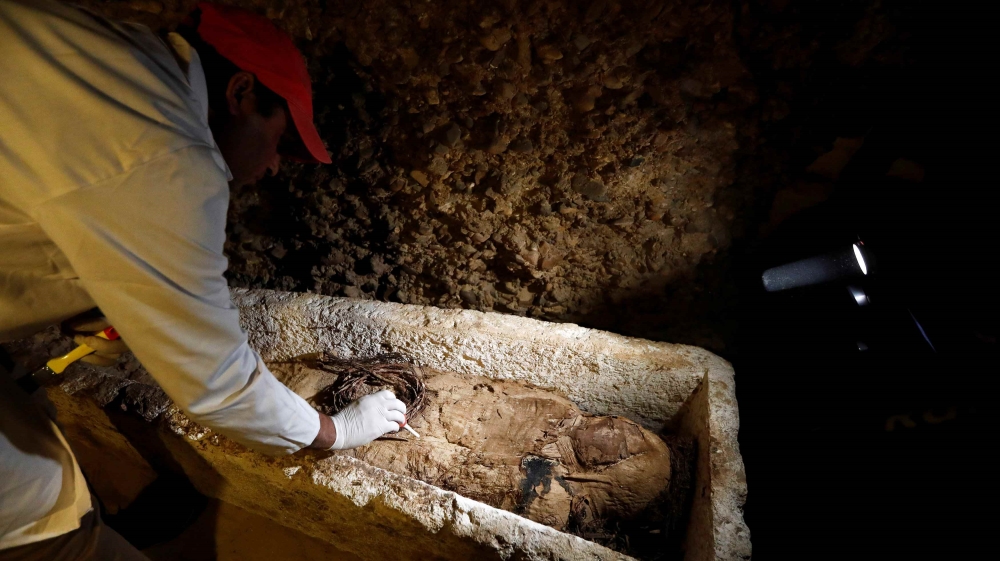A 3,500 year old desert tomb discovered at the ancient Nile quarry site of Gebel el-Silsila, in Upper Egypt, is being described by archaeologists as the “watery grave for 50 to 60 ancient Egyptians.”
The Egyptian team of archaeologists announced the discovery of the mass grave on December 13 but made the initial discovery “almost two years ago ” according to an announcement made in an Egyptian Ministry of Antiquities Facebook Post about the discovery. Gebel el-Silsila is situated in a narrow part of the Nile about 40 miles (65 kilometers) north of Aswan and the site was a major quarry site about 3,550 years ago during the 18th Dynasty of Egypt.
John Ward, the assistant mission director of the Gebel El-Silsila survey project , led by his wife Dr. Maria Nilsson, told Live Science , “The newly discovered tomb sits at the bottom of a 16.5-foot-deep (5 meters) shaft hewn out of the bedrock.” The tomb consists of “two chambers” and one has remained inaccessible to archaeologists “because it’s filled with debris and silt” said Ward.

One of the two chambers is accessible and is being painstakingly investigated. (Courtesy of © Gebel el Silsila Project )
The two chambers were found to be “filled with briny water from a naturally occurring spring,” and the human remains inside were “jumbled.” Archaeologists must now run water pumps into the tomb before they can hand-sift for bones and artifacts; “We’re actually sitting in this soup, so to speak, of human remains,” said Ward. A bit grim, however, scientists will be scientists.

A child’s sarcophagus filled with silt being recovered from the flooded mass tomb in Egypt. (Ministry of Antiquities)
Hand-Sifting Through ‘Human Soup’, This ChristmasWriting in her Blog, the excavation leader Dr. Maria Nilsson said, “No other tomb documented at Gebel el-Silsila previously has contained such a high number of entombed individuals.” And Nilsson added: “One of the more important results of the discovery at Gebel el-Silsila is the amount of buried children and women, indicating that there was a complete society with entire families living and working in ancient Kheny.”

The tomb was grave for men, women and children of Egypt. ( Courtesy Gebel el Silsila Project )
According to the Ministry of Antiquities Facebook Post , Ward said that in the main chamber alone, “researchers have found three sarcophagi. One contained the remains of a child; the other an infant. The third is also infant-sized, but has not yet been fully studied.” It was around these Ancient Egyptian coffins that the “bones of at least 50 other people, about two-thirds adults and one-third children” were found “jumbled.”
Adding to the archaeologists’ excitement is that “all” of the other tombs discovered at Gebel el-Silsila have been looted, so to Ward this is “like Christmas every day.” And this Christmas Day Ward and his wife Dr. Nilsson will be shoulder deep in broken bone-filled water, a prospect that Ward told reporters at Live Science was, “humbling.”

The chambers have been cut from the bedrock. (Courtesy Gebel el Silsila Project )
In Service, But Not In SlaveryThe archaeologists’ strategy is to access the third sarcophagus and the second room, “We’re trying to figure out why so many people were buried in one place,” Ward said. A key observation which the scientists are finding to be exceptionally informative is that, “Many of the adult males show signs of broken bones and back problems, indicating that they were likely quarry laborers.”

There is very limited access between the chambers. (Egyptian Ministry of Antiquities)
“The newfound tomb also indicates that these workers weren’t slaves. The bodies were found with amulets, including shabtis — small figurines buried with the dead to act as their own manual laborers in the afterlife. Slaves wouldn’t have been buried with shabtis.”

Artifacts found at the site include shabtis, amulets, scarabs belonging to various periods between Thutmosis II-Amenhotep II. The scarab shown above is of Men-Kheper-Re i.e. Thutmosis III. (Courtesy of Gebel el Silsila Project and Ministry of Antiquities)

A 2016 Egypt Today article discusses an earlier project named “Silsila” which was also under the direction of Dr. Maria Nilsson which “explored the lives of workers, not the lives of the pharaohs and priests who dominated Egyptology research for much of its history.” Deir el-Medina was the village where the artisans resided that crafted the royal tombs of the Valley of the Kings, and these workers left over “five thousand quarry marks and pictorial graffiti, and…several hundred hieroglyphic and hieratic inscriptions.”
This tells archaeologists that the masons at the ancient Nile quarry site of Gebel el-Silsila “were following in a carving tradition which extends back at Silsila to the epipalaeolithic (around 8,000 years ago), predynastic, and early dynastic periods.” Thus, not every construction worker in Egypt was a slave, a concept so often presented in modern interpretations of Ancient Egypt.
Sources:ancient.ournewstimes24.com








